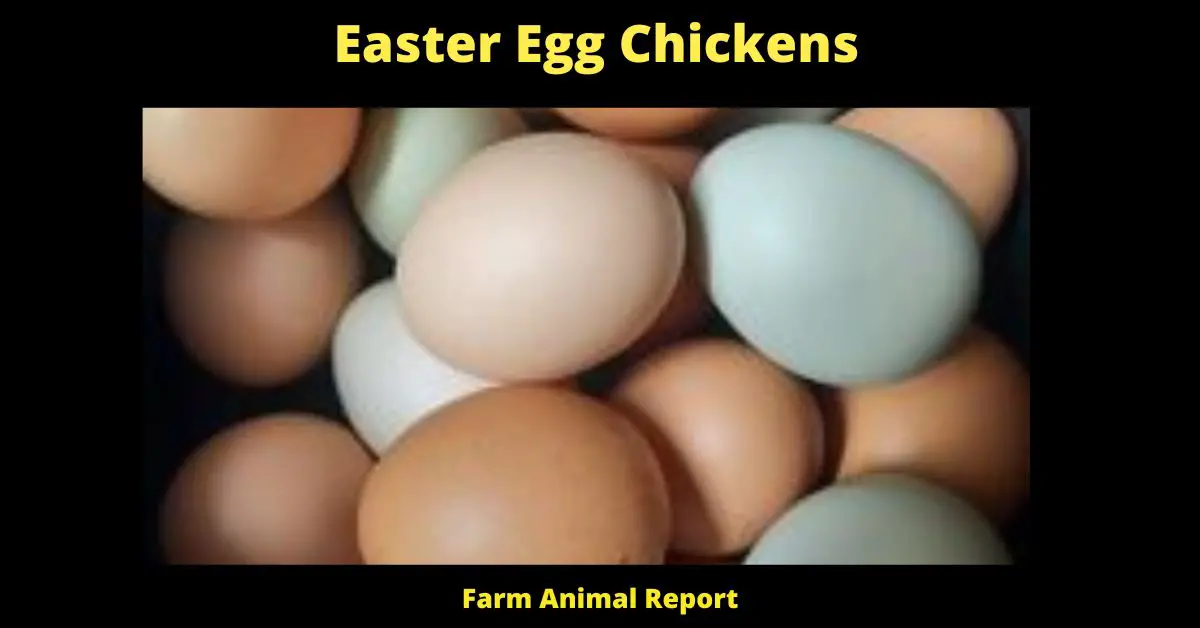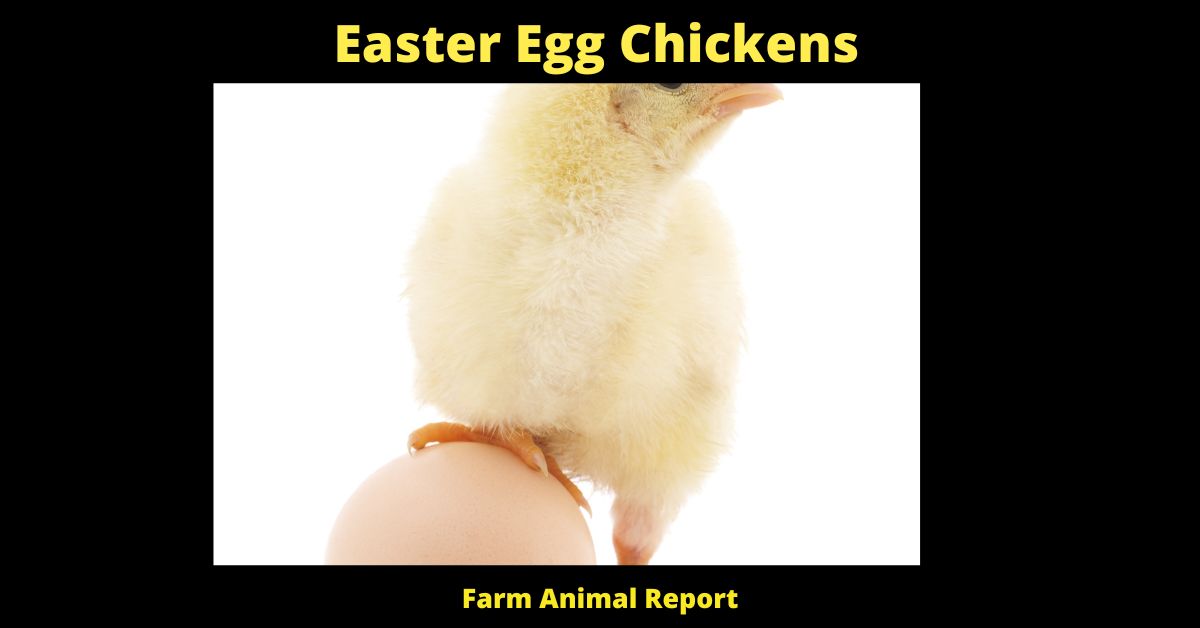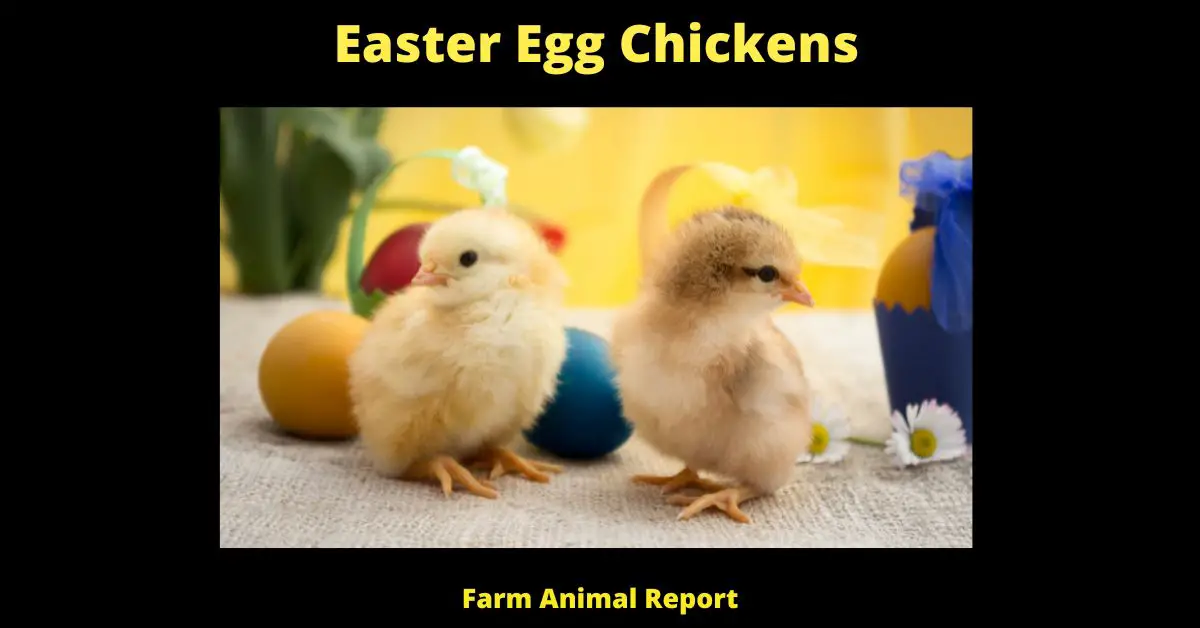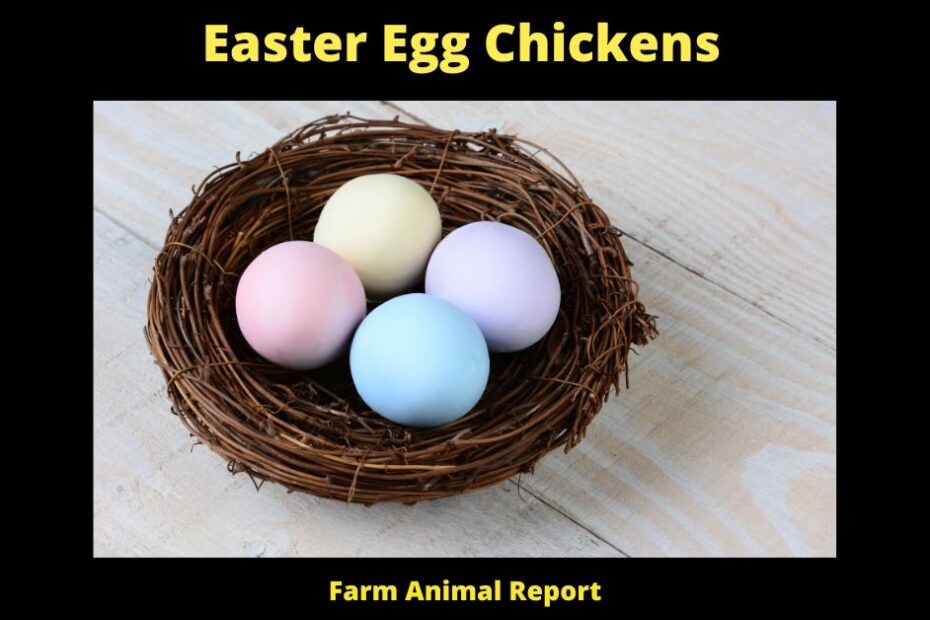Easter Egg Chickens 🐓
Easter Egg chickens, commonly known as Easter Eggers, are fascinating poultry loved for their ability to lay colorful eggs. In this guide, we will dive deep into the world of Easter Eggers, their egg production, the breeds, and so much more about these captivating creatures.
Easter Egger Chickens Eggs 🥚
Easter Egger chicken eggs are a delightful curiosity in the world of poultry, setting themselves apart with their colorful shells. Unlike conventional chicken breeds that lay white or brown eggs, Easter Eggers can produce eggs in an array of colors, from blue and green to pink, cream, and occasionally even yellow.
This chromatic variety is primarily due to the “oocyanin” pigment, which is deposited as the egg passes through the hen’s oviduct. Each Easter Egger hen typically lays one specific color of egg throughout her life, although the shade can vary slightly.
In terms of production, Easter Eggers are relatively good layers, averaging between 200 to 280 eggs per year, or around 4 to 5 eggs per week. These eggs are usually medium to large in size and are as nutritious and delicious as any other chicken egg. The colorful eggs not only add a whimsical touch to your egg basket but are also a big hit with kids and can be a unique selling point if you’re considering selling eggs locally.
It’s essential to note that Easter Egger chickens are not a recognized breed but rather a variety of chicken that carries the blue egg-laying gene. Therefore, there may be variations in egg production and color even within the same flock. These charming birds add a splash of color to your poultry experience, making each trip to the chicken coop feel like an Easter egg hunt!
Are Easter Egger Chickens Good For Eggs 🥚
Absolutely! Easter Eggers are primarily known and raised for their egg-laying abilities. While they aren’t prolific layers like some commercial breeds, they make up for it with their unique, colorful eggs that range from blue to green and sometimes even pink.

here’s a simple table to give you an overview of the egg-laying qualities of Easter Eggers compared to some other popular chicken breeds known for their egg production. The information is presented in a straightforward manner for easy understanding.
| Chicken Breed | Average Eggs per Year | Egg Size | Egg Color | Laying Age (Weeks) | Good Layer for Backyard Flocks? |
|---|---|---|---|---|---|
| Easter Egger | 200-280 | Medium | Blue, Green, Pink, Cream | 18-24 | Yes |
| White Leghorn | 280-320 | Medium | White | 16-18 | Yes |
| Rhode Island Red | 200-300 | Large | Brown | 18-24 | Yes |
| Plymouth Rock (Barred Rock) | 200-280 | Large | Brown | 18-24 | Yes |
| Sussex | 250-275 | Large | Light Brown | 16-20 | Yes |
| Orpington | 175-200 | Large | Brown | 18-24 | Moderate |
| Wyandotte | 200-240 | Large | Brown | 18-20 | Yes |
| Ameraucana | 250-270 | Medium | Blue | 18-24 | Yes |
| Araucana | 200-230 | Medium | Blue | 20-24 | Moderate |
Note: The numbers are approximate averages and can vary depending on factors like health, care, and individual chicken characteristics. “Good Layer for Backyard Flocks?” is subjective and based on a balance of egg production, temperament, and adaptability.
What Color Eggs do Easter Egger Chickens Lay 🌈
Easter Eggers lay a variety of egg colors. While they are most known for their blue and green eggs, some may lay pink, cream, or even yellow eggs. The exact color can be a delightful surprise for many poultry enthusiasts.
the variety in egg colors laid by Easter Egger chickens can be quite fascinating. Various factors contribute to the different hues. Below is a table that explains some of these factors and their impact on the color of the eggs laid by Easter Egger chickens:
| Factor | Impact on Egg Color | Explanation |
|---|---|---|
| Genetics | Primary factor | The genetics of each individual Easter Egger hen determine the color of the egg she will lay. |
| Diet | Minimal | While diet mostly affects yolk color, it has minimal impact on shell color. |
| Hen’s Age | Minimal | Younger hens often lay lighter-colored eggs that may darken slightly as they age. |
| Stress | Minimal | Stress may affect the laying cycle but generally has minimal impact on egg color. |
| Environmental Conditions | Minimal | Temperature, humidity, and light exposure can affect egg laying but not usually the color. |
| Laying Frequency | Moderate | Hens that lay less frequently often deposit more pigments, which could darken the egg’s color slightly. |
| Presence of “Oocyanin” Pigment | Determines Blue/Green Hue | The presence of the oocyanin pigment specifically results in blue or greenish hues. |
Note: It’s essential to understand that each Easter Egger hen will typically lay eggs of one specific color throughout her lifetime. The factors mentioned can have slight impacts on the shade, but the fundamental color is genetically determined and remains relatively constant.

How Many Eggs do Easter Egger lay 📆
On average, an Easter Egger chicken will lay around 200-280 eggs per year. This equates to 4 to 5 eggs per week.
Do Easter Eggers always lay green Eggs 🤔
No, Easter Eggers don’t always lay green eggs. While green is a common color, the range includes blue, pink, cream, and sometimes yellow.
Proper nutrition is crucial for any chicken breed, including Easter Eggers, especially if you’re looking forward to a colorful array of eggs. Below is a table outlining the optimal food types and their benefits for Easter Egger chickens:
| Food Type | Nutrient Focus | Benefits for Easter Egger Chickens | Recommended Amount |
|---|---|---|---|
| Layer Pellets | Balanced Nutrition | Provides essential nutrients like calcium for strong eggshells | Free-choice or approx. 1/4 lb per chicken per day |
| Grit | Digestion | Helps in breaking down grains and other food in the gizzard | Free-choice in a separate dish |
| Fresh Fruits & Veggies | Vitamins & Minerals | Adds variety and essential micronutrients to the diet | Small amounts; avoid salty or sugary foods |
| Oyster Shell | Calcium | Additional source of calcium for stronger eggshells | Free-choice in a separate dish |
| Corn | Energy | Provides extra energy, especially in colder months | Small amounts mixed with other food |
| Clean Water | Hydration | Essential for egg production and overall health | Always available; refill daily |
| Insect Protein | Protein | Essential for feather growth and egg production | Small amounts or as treats |
| Fish Meal | Omega-3 Fatty Acids | Can improve egg quality and hen’s overall health | Up to 5% of total diet |
| Sunflower Seeds | Healthy Fats & Protein | Good for feather quality and additional energy | Small amounts as treats |
Note: The recommended amounts are approximate and can vary based on the chicken’s age, health, and existing diet. Always consult a veterinarian for specific dietary needs.
This table should serve as a guide for providing a balanced diet to your Easter Egger chickens, thereby optimizing their health and egg-laying capabilities.
Do Easter Eggers have Combs 🐔
Yes, Easter Egger chickens do have combs, but the type and size of the comb can vary widely among individual birds. The reason for this variability is that Easter Eggers are not a standardized breed but rather a mixed variety of chickens with the capability to lay colored eggs. Therefore, they can inherit different comb types from their diverse genetic backgrounds.
The most common types of combs you might see on an Easter Egger include the single comb, which has a row of points facing upwards, and the pea comb, which is smaller and closer to the head with three distinct ridges. The pea comb is often associated with the blue egg-laying gene, and it is less susceptible to frostbite compared to the more protruding single comb, making Easter Eggers with pea combs better suited for colder climates.

While the comb’s presence is generally more pronounced in roosters, hens also possess combs but they are usually smaller and less vibrant. The comb serves various functions, including aiding in temperature regulation and being a sign of fertility and health.
It’s important to note that while the comb can be a helpful indicator for various chicken attributes, it’s not a foolproof method for determining factors like egg-laying ability, sex at a very young age, or overall health. Always consult more comprehensive measures and perhaps even veterinary advice for more specific inquiries.
At What Age Can you Tell if a Chicken is a Rooster 🧐
Typically, by the age of 6-8 weeks, you can start distinguishing a rooster from a hen in many chicken breeds, including Easter Eggers, by observing the comb’s size and color.
Certainly, identifying a rooster from a chick to a mature bird involves observing various signs and changes in behavior and physical appearance. Here’s a table that breaks down some key indicators at different stages of life to help you identify roosters:
| Age Range | Physical Traits | Behavioral Traits | Other Notes |
|---|---|---|---|
| Day 1-7 | Almost indistinguishable from hens | Generally similar to hens | Vent sexing possible but best left to professionals |
| Week 1-4 | Slightly larger legs and comb | Still similar to hens | Wing feather sexing might be possible for some breeds |
| Week 5-8 | Comb and wattles start to grow and darken | More active and assertive | Some breeds show early comb growth in roosters |
| Week 9-12 | Comb and wattles more prominent; tail feathers might start to curve | May attempt to crow; more territorial | Look for a pronounced difference in comb and wattle growth compared to hens |
| Week 13-18 | Definitive comb and wattle growth; Hackle feathers may become pointed | Crow more consistently; may show interest in hens | Most roosters are fairly easy to identify by this stage |
| Week 19-24 | Matured comb and wattle; Saddle feathers elongate | Established crow; may start to show mating behavior | Roosters will have a fully developed comb and wattle |
| 24 weeks and beyond | Fully developed comb, wattle, and plumage | Displays full range of rooster behaviors, including guarding the flock | Behavior and appearance should leave no doubt |
Note: The above indicators are general and may vary depending on the breed and individual chicken characteristics. Some breeds have hens with pronounced combs and wattles, and some roosters are late bloomers. If you’re unsure, it’s always good to consult a veterinarian or poultry expert for a more accurate identification.
What is the Disposition of an Easter Egger Rooster 😇
Easter Egger roosters generally have a calm and friendly disposition. However, individual personalities can vary, so it’s always good to observe each rooster’s behavior.
The disposition or temperament of a rooster can be an important factor, especially for those keeping backyard flocks. Below is a table that provides a general overview of the disposition of Easter Egger roosters compared to some other popular chicken breeds:
| Chicken Breed | General Disposition of Rooster | Other Notes |
|---|---|---|
| Easter Egger | Generally docile but can vary | Tends to be good with people but disposition is not standardized due to mixed breeding |
| Rhode Island Red | Can be aggressive | Known for its dominant and sometimes confrontational nature |
| Leghorn | Active but tends to be aloof | Generally not aggressive but usually avoids human interaction |
| Orpington | Very docile | One of the calmest and most easy-going rooster breeds |
| Plymouth Rock (Barred Rock) | Usually friendly and docile | Often good around people and other chickens |
| Wyandotte | Generally docile | Usually calm but can sometimes be assertive |
| Sussex | Friendly and calm | Good for families and gets along well with other breeds |
| Silkie | Extremely docile | Known for their friendly and gentle nature |
| Ameraucana | Generally calm and non-aggressive | Closely related to Easter Eggers; tends to be good around people |
| Araucana | Varies but often docile | Ancestors to Easter Eggers; generally non-aggressive |
Note: The above descriptions are generalizations and individual roosters may display a range of behaviors within or outside these general traits. Also, the way a rooster is raised and socialized can have a big impact on his disposition.
When it comes to Easter Egger roosters, their disposition can be a bit of a wildcard due to the mixed breeding involved. However, they are generally known to be relatively docile, especially when compared to more aggressive breeds like the Rhode Island Red. This makes them a popular choice for backyard flocks.
Are EasterEgger Roosters Protective 🛡️
Yes, like most roosters, Easter Egger roosters are protective of their flock and will defend their hens from perceived threats.
Easter Egger Egg Production 📊
understanding the egg production of Easter Egger chickens can help you manage your flock more effectively. Here’s a table outlining the egg production of Easter Eggers by day, week, and year, as well as by the age of the chicken:
| Age Range | Average Eggs Per Day | Average Eggs Per Week | Average Eggs Per Year | Notes |
|---|---|---|---|---|
| 0-18 weeks | 0 | 0 | 0 | Chickens generally start laying after 18-24 weeks |
| 19-30 weeks | 0.3 – 0.5 | 2 – 4 | ~120 – 150 | Peak laying period for many hens |
| 31-52 weeks | 0.2 – 0.4 | 1 – 3 | ~70 – 100 | Production slows down after peak |
| 1-2 years | 0.2 – 0.4 | 1 – 3 | ~50 – 100 | Egg production may gradually decrease |
| 3 years & older | 0.1 – 0.3 | 1 – 2 | ~35 – 50 | Decline in production due to age |
Note: The numbers given are approximate averages and can vary depending on numerous factors, including health, diet, and environmental conditions. Easter Eggers are known for their varied egg colors, but the rate of production is generally consistent with medium to good layer breeds. They usually lay between 200-280 eggs per year during their peak production years.
Keep in mind that Easter Eggers, like all chickens, will have fluctuating egg production based on seasonality, molt periods, and age. Younger hens typically lay more eggs, with production slowing as they age. Proper care, including a balanced diet and stress reduction, can help maintain a consistent laying schedule.
How Many Eggs do Easter Eggers Produce 📅
As mentioned earlier, Easter Eggers typically produce between 200-280 eggs annually.
How Many Eggs do Easter Eggers lay a week 📆
On average, an Easter Egger will lay between 4 to 5 eggs every week.
What Percentage of Easter Eggers lay blue Eggs 🔵
While the exact percentage can vary, it’s estimated that around 50% of Easter Eggers lay blue eggs. The remaining percentage is distributed among the other colors like green, pink, and cream.
ertainly, the egg colors from Easter Eggers can be one of the most exciting aspects of raising this type of chicken. However, it’s important to note that egg color can vary greatly due to a number of factors. Below is a table illustrating the approximate percentages of various egg colors you might expect from an Easter Egger flock, as well as the factors that can affect these colors.
| Egg Color | Approximate Percentage in Flock | Factors Affecting Color |
|---|---|---|
| Blue | 30-40% | Genetics, Diet |
| Green | 20-30% | Genetics, Diet |
| Brown | 10-20% | Genetics, Diet, Age |
| Pink | 5-10% | Genetics, Diet, Age |
| Cream | 5-10% | Genetics, Diet, Age |
| Other/Multi-color | 1-5% | Genetics, Diet, Age |
Note: These percentages are general estimates and can differ based on your specific flock’s genetic makeup.
Factors Affecting Egg Color 🐣
- Genetics: The dominant factor. Chickens inherit egg color genes from their parents.
- Diet: A well-balanced diet can result in more vibrant egg colors.
- Age: As a hen ages, her eggs may become lighter in color.
The diversity of Easter Egger egg colors is part of what makes them so interesting to raise. However, if you’re aiming for a particular egg color, it’s essential to note that individual Easter Eggers often lay eggs of one specific color their entire lives. The variety comes from having multiple hens each laying a different color.
Understanding these factors can help you better predict what to expect from your Easter Egger flock, although surprises are always part of the fun!
Easter Egg Chickens Breeds 🐤
What Types of Chickens Lay Easter Eggs 🎨
Easter Eggers are the primary type known for laying Easter eggs, but other breeds like Ameraucanas and Araucanas also lay blue to green eggs.
understanding the origin and breeding development of Easter Eggers can provide valuable insights into this fascinating variety of chickens. Below is a table that breaks down key points in the history and breeding of Easter Eggers:
| Time Period | Location | Key Developments | Notes |
|---|---|---|---|
| Ancient Times | South America | Domestication of Araucana chickens | Ancestors to Easter Eggers; blue egg layers |
| 19th Century | Europe/USA | Import of Araucanas and Ameraucanas | Further developed into unique breeds |
| Early 20th Century | USA | Breeding Ameraucanas | Recognized by American Poultry Association (APA) |
| Mid 20th Century | USA | Development of “Easter Eggers” | Not standardized; mixed breeds capable of laying colored eggs |
| Late 20th Century | Worldwide | Popularization of Easter Eggers | Gained popularity for colorful eggs and docile nature |
| 21st Century | Worldwide | Backyard poultry & niche market | Increased demand due to unique egg colors and adaptability |
Note: The term “Easter Egger” generally refers to chickens that have the potential to lay colored eggs but don’t meet specific breed standards for Araucanas or Ameraucanas.
Key Points in Breeding Development 🐔
- Araucanas: Originated from South America, known for tufted ears and blue eggs.
- Ameraucanas: Developed in the United States, recognized by the APA, known for muffs, beards, and blue eggs.
- Easter Eggers: A mixed breed developed primarily in the U.S. from Ameraucanas, Araucanas, and other breeds like Leghorns and Orpingtons. Not recognized by APA but valued for their diverse egg colors.
Easter Eggers are often mistakenly labeled as Ameraucanas or Araucanas, but they are technically not a breed. They are a variety of chicken that has been selectively bred for their ability to lay colorful eggs. This makes them a popular choice for backyard flocks and small-scale poultry operations, especially for those interested in a bit of colorful variety.
What Chicken is Called an Easter Egger 🐣
The term “Easter Egger” refers to a mixed breed chicken that possesses the blue egg gene, but it isn’t purebred like Ameraucanas or Araucanas.
Are there Different Types of Easter Eggers 🌈
Technically, Easter Eggers are not a standardized breed but a variety of mixed breed chickens. So, there can be many different “types” or variations, all laying a variety of colored eggs.
How Can you Tell if a Chicken is an Easter Egger 🔍
It’s hard to tell just by looking. The best way is to observe the color of the eggs they lay. A variety of egg colors, especially blue and green, is a good indicator.
Purchasing Easter Egger chickens can be an exciting experience, especially if you’re looking forward to the prospect of colorful eggs. However, there are some important considerations to keep in mind. Here is a table providing the best advice for buying Easter Eggers:
| Consideration | Best Advice | Notes |
|---|---|---|
| Source | Choose reputable breeders or hatcheries | Ensures healthy birds and better chances of colorful eggs |
| Age | Know what you’re getting; chicks or adult birds | Chicks are cheaper but require more care; adults have known egg colors |
| Health | Check for signs of illness; bright eyes, smooth feathers, energetic | Healthy birds are less likely to transmit diseases to your flock |
| Gender | Confirm gender if possible | Be sure if you’re getting hens for eggs or roosters for breeding |
| Egg Color Expectations | Manage expectations | Egg colors can be unpredictable; no guarantees |
| Housing & Feed | Prepare housing and feed in advance | Chickens will need immediate access to shelter and appropriate food |
| Cost | Budget for initial and ongoing costs | Consider the price of the bird, plus feed, housing, and healthcare |
| Documentation | Request any available records | Health records, age, and sometimes even lineage may be available |
Note: While Easter Eggers are generally known for their colorful eggs, it’s crucial to remember that not all will lay the unique blue or green eggs. It varies from chicken to chicken, and reputable sources will offer the most reliable chances for colorful eggs.
Taking these factors into account can help ensure that you make an informed and satisfying purchase. Easter Eggers are a popular and rewarding choice for many backyard poultry keepers, and with the right preparation and knowledge, they can be a joyful addition to your flock.
Final Thoughts 🧠Easter Egg Chickens
To summarize, here are 7 positive action steps for Easter Egger enthusiasts:
- 🥚 Raise Easter Eggers for a colorful egg basket.
- 📅 Expect 4-5 eggs per week from each hen.
- 🌈 Embrace the surprise element in egg colors.
- 🐔 Observe combs early to distinguish roosters from hens.
- 😇 Treat every rooster as an individual; their temperaments can vary.
- 📊 Remember that about half of the Easter Eggers might lay blue eggs.
- 🔍 Look for egg color variations to identify an Easter Egger.
Enjoy your journey with these beautiful, colorful egg-laying wonders!


